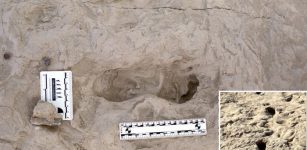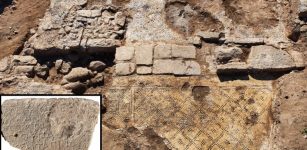Well-Preserved Neolithic Settlement Discovered Near Kutná Hora, Czech Republic
Jan Bartek - AncientPages.com - Archaeologists excavating near the central Bohemian town of Kutná Hora in the Czech Republic have unearthed an extremely well-preserved Neolithic settlement.
The settlement "Dobřeň," named after a nearby central Bohemian village, dates back approximately 7,000 years and features floor plans of four long houses. This discovery provides valuable new information about the lifestyles of early European agricultural societies.
Credit: Daniel Pilař, The Institute of Archaeology of the CAS, Prague.
The site was uncovered during routine rescue excavations in early spring. Archaeologists typically monitor construction work in the area, and during one such project, they unexpectedly encountered remnants of an atypical settlement for the region. Upon observing the house plans, the archaeologists immediately identified the site as a Neolithic settlement.
Credit: Daniel Pilař, The Institute of Archaeology of the CAS, Prague.
This finding is significant because it offers a rare glimpse into Neolithic communities' architectural and social structures in this part of Europe. The presence of long houses is particularly noteworthy, as these structures are characteristic of early farming societies and can provide insights into their social organization, building techniques, and daily life.
According to Daniel Pilař from the Czech Academy of Sciences’ Department of Prehistorical Archaeology, the Dobřeň settlement is unique due to its preservation.
"It’s a miracle that this site was not overlaid or destroyed in later millennia. Prehistoric settlements are usually situated in the most fertile regions that are suitable for agriculture. That means that in one place there was usually a Neolithic settlement, and later also a Bronze Age or Iron Age settlement. So Neolithic settlements are very often destroyed or are harder to read from the archaeological point of view.
But with Dobřeň it’s different. We think it was only used for a short period of time, maybe by a few generations. And in the next millennia, this place was never used, at least for living. So it offers us great insight into the Neolithic world,” Pilař told the Czech Radio.
The excavation revealed the ground plans of four wooden structures, with stone-lined foundations measuring 5m wide and 10-20m long, indicating large dwellings for the era. Numerous pits, initially used for clay extraction and later for waste disposal, provide insights into Neolithic life.
Credit: Daniel Pilař, The Institute of Archaeology of the CAS, Prague.
Previous research showed the settlement belonged to early farmers who migrated from the Balkans. Artifacts found include ceramic vessels for cooking and storage, flint blades for hunting and harvesting, and polished stone tools for carpentry and milling.
Modern scientific analyses allow precise dating, determination of tool use, and insights into the region's environment 7,000 years ago.
See also: More Archaeology News
The location in question appears to be a potentially suitable site for a Neolithic settlement due to its topographical features, specifically its position on a gentle incline between two watercourses, which would have provided a readily accessible source of fresh water. However, it is hypothesized that the early settlers were likely unaware of the soil's insufficient fertility.
Despite this, the settlement probably persisted for multiple generations before its eventual abandonment. Subsequently, the area remained uninhabited until the High Medieval Era, when a new population equipped with significantly advanced agricultural technologies recolonized the region. This settlement has maintained continuous habitation from that period to the present day.
Written by Jan Bartek - AncientPages.com Staff Writer























